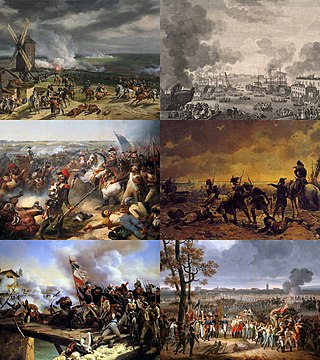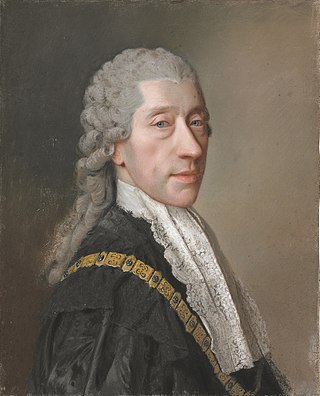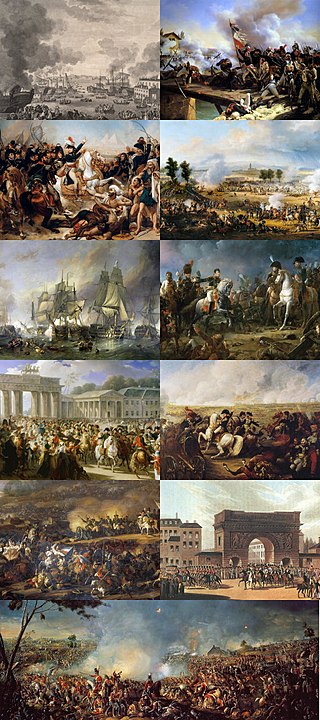
The War of the First Coalition was a set of wars that several European powers fought between 1792 and 1797, initially against the constitutional Kingdom of France and then the French Republic that succeeded it. They were only loosely allied and fought without much apparent coordination or agreement; each power had its eye on a different part of France it wanted to appropriate after a French defeat, which never occurred.
The Treaty of Paris, signed on 30 May 1814, ended the war between France and the Sixth Coalition, part of the Napoleonic Wars, following an armistice signed on 23 April between Charles, Count of Artois, and the allies. The treaty set the borders for France under the House of Bourbon and restored territories to other nations. It is sometimes called the First Peace of Paris, as another one followed in 1815.

The Kingdom of Prussia constituted the German state of Prussia between 1701 and 1918. It was the driving force behind the unification of Germany in 1866 and was the leading state of the German Empire until its dissolution in 1918. Although it took its name from the region called Prussia, it was based in the Margraviate of Brandenburg. Its capital was Berlin.

The Southern Netherlands, also called the Catholic Netherlands, were the parts of the Low Countries belonging to the Holy Roman Empire which were at first largely controlled by Habsburg Spain and later by the Austrian Habsburgs until occupied and annexed by Revolutionary France (1794–1815).
The Treaty of Hubertusburg was signed on 15 February 1763 at Hubertusburg Castle by Prussia, Austria and Saxony to end the Third Silesian War. Together with the Treaty of Paris, signed five days earlier, it marked the end of the Seven Years' War. The treaty ended the continental conflict with no significant changes in prewar borders. Austria and Saxony renounced all claims to the Silesian territories ceded to Prussia in the 1742 Treaty of Berlin and the 1745 Treaty of Dresden. Prussia clearly stood among the ranks of the European great powers, while the treaty enhanced the rivalry with Austria.

The War of the Second Coalition was the second war targeting revolutionary France by many European monarchies, led by Britain, Austria, and Russia and including the Ottoman Empire, Portugal, Naples and various German monarchies. Prussia did not join the coalition, while Spain supported France.

The Battle of Moys was fought on 7 September 1757 during the Third Silesian War. A Prussian army of 13,000 men fought an Austrian army of double their size. The Prussians were defeated and their commander killed.

The Diplomatic Revolution of 1756 was the reversal of longstanding alliances in Europe between the War of the Austrian Succession and the Seven Years' War. Austria went from an ally of Britain to an ally of France; the Dutch Republic, a long-standing British ally, became more anti-British and took a neutral stance while Prussia became an ally of Britain. The most influential diplomat involved was an Austrian statesman, Wenzel Anton von Kaunitz.

French–German (Franco-German) enmity was the idea of unavoidably hostile relations and mutual revanchism between Germans and French people that arose in the 16th century and became popular with the Franco-Prussian War of 1870–1871. It was an important factor in the unification of Germany, World War I, and ended after World War II, when under the influence of the Cold War, West Germany and France both became part of NATO and the European Coal and Steel Community.

The term French–Habsburg rivalry describes the rivalry between France and the House of Habsburg. The Habsburgs headed an expansive and evolving empire that included, at various times, the Holy Roman Empire, the Spanish Empire, Austria, Bohemia and Hungary from the Diet of Augsburg in the High Middle Ages until the dissolution of the monarchy following World War I in the late modern period.

The Seven Years' War (1756–1763) was a global conflict involving most of the European great powers, fought primarily in Europe and the Americas. One of the opposing alliances was led by Great Britain and Prussia. The other alliance was led by France, backed by Spain, Saxony, Sweden, and Russia. Related conflicts include the 1754 to 1763 French and Indian War, and 1762 to 1763 Anglo-Spanish War.

Foreign relations exist between Austria and France. Both countries have had diplomatic relations with each other since the Middle Ages. Both countries are full members of the Council of Europe and the European Union.

The Third Silesian War was a war between Prussia and Austria that lasted from 1756 to 1763 and confirmed Prussia's control of the region of Silesia. The war was fought mainly in Silesia, Bohemia and Upper Saxony and formed one theatre of the Seven Years' War. It was the last of three Silesian Wars fought between Frederick the Great's Prussia and Maria Theresa's Austria in the mid-18th century, all three of which ended in Prussian control of Silesia.

The Franco-Austrian Alliance was a diplomatic and military alliance between France and Austria that was first established in 1756 after the First Treaty of Versailles. It lasted for much of the remainder of the century until it was abandoned during the French Revolution.
The Treaty of Versailles, also known as the First Treaty of Versailles, was a diplomatic agreement between France and Austria. It was signed in 1756 at the Palace of Versailles in France. There were four treaties signed on this agreement.

The Treaty of Versailles was a diplomatic agreement signed between Austria and France at the Palace of Versailles on 1 May 1757 during the Seven Years' War. It expanded on the 1756 First Treaty of Versailles, which had established the Franco-Austrian Alliance. It is thus commonly known as the Second Treaty of Versailles.

The Invasion of Hanover took place in 1757 during the Seven Years' War when a French army under Louis Charles César Le Tellier, duc d'Estrées advanced into the Electorate of Hanover and neighbouring German states, following the Battle of Hastenbeck. French forces overran most of Hanover. This action forced the Hanoverian Army of Observation, intended to defend the Electorate, to Stade on the North Sea coast. At the Convention of Klosterzeven the Duke of Cumberland agreed to disband his army and acknowledge the French occupation of the Electorate.

Wenzel Anton, Prince of Kaunitz-Rietberg was an Austrian and Czech diplomat and statesman in the Habsburg monarchy. A proponent of enlightened absolutism, he held the office of State Chancellor for about four decades and was responsible for the foreign policies during the reigns of Maria Theresa, Joseph II, and Leopold II. In 1764, he was elevated to the noble rank of a Prince of the Holy Roman Empire (Reichfürst).

The French Revolutionary and Napoleonic Wars, sometimes called the Great French War, were a series of conflicts between the French and several European monarchies between 1792 and 1815. They encompass first the French Revolutionary Wars against the newly declared French Republic and from 1803 onwards the Napoleonic Wars against First Consul and later Emperor Napoleon Bonaparte. They include the Coalition Wars as a subset: seven wars waged by various military alliances of great European powers, known as Coalitions, against Revolutionary France – later the First French Empire – and its allies between 1792 and 1815:















